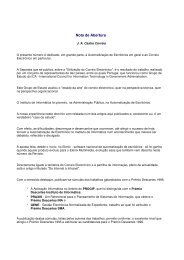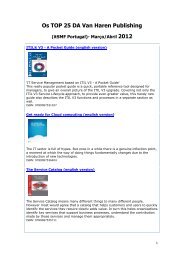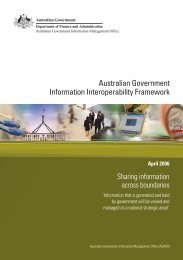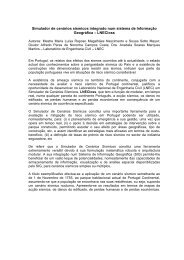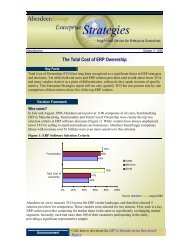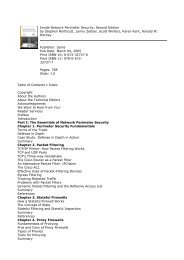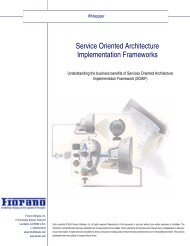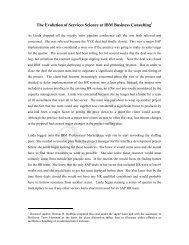OECD Peer Review of E-Government in Denmark - ePractice.eu
OECD Peer Review of E-Government in Denmark - ePractice.eu
OECD Peer Review of E-Government in Denmark - ePractice.eu
You also want an ePaper? Increase the reach of your titles
YUMPU automatically turns print PDFs into web optimized ePapers that Google loves.
other reforms. The plan identified specific benefits that ICT could deliver to Danes, such as a better<br />
quality <strong>of</strong> life and <strong>in</strong>creased economic growth. It also po<strong>in</strong>ted out that “new” jobs would go to the<br />
“front-runner” countries. <strong>Denmark</strong>’s use <strong>of</strong> ICT could henceforth be considered a question related to<br />
the welfare <strong>of</strong> Danish society.<br />
The Danish model for ICT development formulated <strong>in</strong> the report was based on a mix <strong>of</strong> market<br />
forces and public sector <strong>in</strong>volvement. This mix was considered necessary to atta<strong>in</strong> the follow<strong>in</strong>g goals:<br />
• ICT should support free access to, and exchange <strong>of</strong>, <strong>in</strong>formation.<br />
• ICT should support democracy and give <strong>in</strong>dividuals the opportunity to exercise their<br />
<strong>in</strong>fluence.<br />
• ICT should support peoples’ personal development, both at work and <strong>in</strong> their leisure time.<br />
• ICT should support openness and transparency <strong>in</strong> the public sector, contribute to the<br />
promotion <strong>of</strong> efficiency and rationalisation <strong>in</strong> public <strong>in</strong>stitutions, and enable them to provide<br />
better services.<br />
• ICT should be used to susta<strong>in</strong> the disadvantaged <strong>of</strong> society.<br />
The report emphasised the importance <strong>of</strong> public <strong>in</strong>stitutions and bus<strong>in</strong>esses be<strong>in</strong>g tied together by<br />
means <strong>of</strong> modern ICT <strong>in</strong> order to create new and better services for citizens. It determ<strong>in</strong>ed that the<br />
public adm<strong>in</strong>istration at both the State and local levels must be connected by an “electronic service<br />
network”, which would enable it to provide better services for both citizens and bus<strong>in</strong>esses, and result<br />
<strong>in</strong> a more efficient adm<strong>in</strong>istration with which bus<strong>in</strong>esses and citizens would have the ability to<br />
communicate digitally. In support <strong>of</strong> this, legislation around public registers had to be reviewed and<br />
simplified so that registration, comb<strong>in</strong>ation and use <strong>of</strong> data for all legal and adm<strong>in</strong>istrative purposes<br />
could take place without barriers be<strong>in</strong>g created by unnecessary bureaucratic procedures.<br />
Other major objectives set by the report <strong>in</strong>cluded establishment <strong>of</strong> a nationwide health network<br />
for exchange <strong>of</strong> <strong>in</strong>formation between doctors, hospitals, pharmacies and health authorities, and an<br />
electronic network where all bus<strong>in</strong>esses could exchange bus<strong>in</strong>ess documents (i.e. EDI). Overall, the<br />
objectives were very wide-rang<strong>in</strong>g, cover<strong>in</strong>g not only general public adm<strong>in</strong>istration and the health and<br />
bus<strong>in</strong>ess sectors, but also research, personal data protection, <strong>in</strong>formation security, education, culture,<br />
the media, telecommunications, transport, and issues related to people with disabilities. A key policy<br />
goal was creation <strong>of</strong> a “public network” <strong>of</strong> computer and telecommunications networks which, to<br />
average citizens and bus<strong>in</strong>esses, would appear to be as easy to understand and as readily accessible as<br />
the telephone system.<br />
The Danish <strong>Government</strong>’s IT action plans<br />
Publication <strong>of</strong> the first IT action plan started a tradition <strong>of</strong> government submitt<strong>in</strong>g annual IT<br />
action plans to the Parliament. Created by the M<strong>in</strong>istry <strong>of</strong> Research and Information Technology, the<br />
plans put the major themes <strong>of</strong> the <strong>in</strong>formation society <strong>in</strong> the foreground <strong>of</strong> public attention and<br />
political debate, took stock <strong>of</strong> the current situation, and adjusted the course if ICT developments <strong>in</strong><br />
<strong>Denmark</strong>.<br />
The 1995 IT action plan conta<strong>in</strong>ed specific goals and deadl<strong>in</strong>es; priority was given to solv<strong>in</strong>g<br />
some key problems such as <strong>in</strong>frastructure development, legislative updat<strong>in</strong>g, and the establishment <strong>of</strong><br />
standards. The strategy was to advance along a broad front aimed at generat<strong>in</strong>g a synergy between<br />
174



